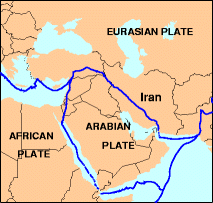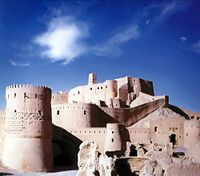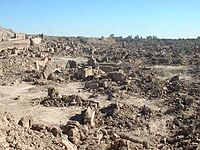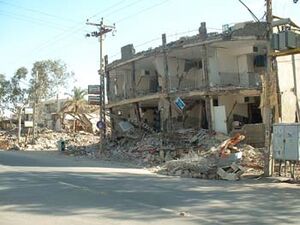2003 Bam earthquake facts for kids

Destruction in Bam
|
|
| UTC time | 2003-12-26 01:56:52 |
|---|---|
| ISC event | 7217667 |
| USGS-ANSS | ComCat |
| Local date | December 26, 2003 |
| Local time | 05:26 Iran Standard Time |
| Magnitude | 6.6 Mw |
| Depth | 15 km (9.3 mi) |
| Epicenter | 28°51′N 58°15′E / 28.85°N 58.25°E |
| Type | Strike-slip |
| Areas affected | Iran |
| Max. intensity | IX (Violent) |
| Peak acceleration | 0.98 g |
| Casualties | 34,000 dead 200,000 injured 45,000–75,600 displaced |
On December 26, 2003, a powerful earthquake shook the Kerman province in southeastern Iran. It happened at 5:26 AM local time. The earthquake was very strong, measuring 6.6 on the moment magnitude scale. It caused extreme shaking, rated as IX (Violent) on the Mercalli intensity scale.
The city of Bam was hit the hardest. At least 34,000 people died, and up to 200,000 were injured. The damage was made worse because many buildings were made of mud brick. These buildings did not follow the earthquake safety rules that were put in place in 1989.
After the earthquake, the U.S. offered help to Iran. In return, Iran agreed to let the International Atomic Energy Agency check its nuclear activities more closely. Many countries, about 44, sent people to help with rescue efforts. Around 60 countries offered other kinds of assistance.
The Iranian government even thought about moving its capital city, Tehran, because of fears of a similar earthquake there. The Bam earthquake also had a lasting emotional impact on many people. After the disaster, Iran created new rules for city planning. They rebuilt Bam using strict earthquake-safe designs. This was a big step, as government officials and international groups worked with local engineers and people to rebuild the city carefully.
Contents
Understanding the Bam Earthquake
About the City of Bam
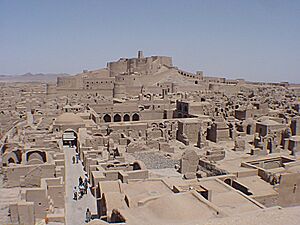
Bam was home to about 97,000 people before the earthquake. It is a popular place for tourists in Iran. One of its most famous spots is the Bam Citadel, a huge fortress made of mud brick that is 2,000 years old.
During the Safavid dynasty (1501–1736), Bam was an important trading center. This was because it was located on the famous Silk Road. The city became less important after an invasion in 1722. It was used as an army camp until 1932. In 1953, Bam became a tourist attraction when work began to restore its old parts.
Why Earthquakes Happen in Iran
Iran experiences many earthquakes, with small ones happening almost every day. The 2003 Bam earthquake happened because of the movement of tectonic plates. The Arabian plate is slowly moving north and pushing against the Eurasian plate. This movement causes stress in the Earth's crust.
Earthquakes occur when this stress causes parts of the Earth's crust to suddenly slip along faults. The Bam earthquake was caused by a specific type of movement called a strike-slip fault. This means the ground moved sideways. Scientists believe the earthquake happened on a hidden fault near Bam.
Damage and Impact of the Quake
The earthquake struck at 5:26 AM on December 26, 2003. Its center was about 10 kilometres (6 mi) southwest of Bam. The worst damage was in Bam and a nearby town called Baravat. Most of the destruction happened within 16 kilometres (10 mi) of Bam.
Over 26,000 people died, and 30,000 were injured. This made it the deadliest earthquake in Iran's history. Many students and teachers were among those who died. This caused a big problem for the local schools.
About 90% of buildings in Bam were damaged or destroyed. Around 70% of homes were completely ruined. This left an estimated 100,000 people without homes. In Baravat, not a single house was left standing.
Many houses in Bam were built by their owners using traditional mud-brick methods. These buildings were not strong enough to survive such a powerful earthquake. They did not use proper materials or skilled builders. On the other hand, newer, taller buildings in Iran often followed stricter safety rules.
One reason for so many deaths was that when walls fell, heavy roofs collapsed. This left very few air pockets for people to survive in. Dust and lack of oxygen also led to people suffocating. The Iranian government promised to punish anyone who did not follow building safety rules.
The famous Bam Citadel was mostly destroyed. This included a large square tower. Electricity and water supplies were also cut off by the earthquake. At least 29 strong aftershocks hit Bam after the main quake.
Life After the Earthquake
Rebuilding Bam
Planning the New City
In January 2004, the United Nations estimated that rebuilding Bam would cost between $700 million and $1 billion. They asked other countries to help pay for this. The Iranian government said it would set aside about $410 million for the reconstruction.
Since mud brick buildings failed so badly, the new buildings in Bam focused on being earthquake-resistant. An official in charge of rebuilding Bam said, "There will be no more mud bricks in Bam." New designs had to use proper earthquake safety methods.
The Iranian government created special groups to guide the rebuilding. These groups included experts who planned how to make the city safer. Local people were also allowed to help choose designs for their new homes. They worked with architects and builders to make sure the new city was well-planned.
Challenges in Rebuilding
Even with careful planning, rebuilding Bam faced challenges. It was hard for everyone involved to agree on decisions. There were different ideas about how the city should look. Also, international help for the actual building was less than expected.
The rebuilding process was also very slow. It took a long time to create a new plan for the city. Two years after the earthquake, the main plan was still not fully approved. This was partly because of disagreements between different groups. As a result, building started without a complete master plan.
Successes of the New Bam
Despite the difficulties, the rebuilding of Bam was very important. It helped improve building standards across Iran. Engineers made sure that the 1989 earthquake safety rules were followed closely.
The rebuilding also brought new chances for Bam's economy. The city's irrigation system, which is vital for its date palm industry, was greatly improved. This helped the date production grow even stronger after the earthquake. The date industry has expanded, creating more jobs and investments.
Helping People Recover
Psychological Support
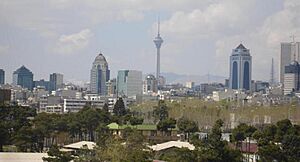
The earthquake had a deep emotional impact on many people. Two hospitals in Bam collapsed, making it hard to care for the injured. Emergency centers were set up, but they were often too crowded. Half of Bam's health workers died in the quake.
The World Health Organization (WHO) asked for $4 million to help with medical relief. A big part of this was helping people with their mental health. Many survivors suffered from post-traumatic stress disorder and depression.
The Iranian Red Crescent Society (IRCS) started a program to help people recover. A year later, they were still helping people with mental health issues. One counseling center saw many new patients with post-traumatic stress disorder.
The Red Cross said that helping people emotionally right after a disaster is very important. They learned from Bam that this support should be given to both victims and rescue workers. The program helped over 9,300 people who needed mental support. Many received counseling. They also offered fun activities like painting and computer classes to help people heal.
Improved Disaster Response
The main hospital in Bam was rebuilt. The temporary hospital is now kept ready for future emergencies, not just in Iran but in the whole region. The Red Cross also helped the Iranian Red Crescent improve its disaster response plans. They built a health center and ten schools. They also trained relief officers and built a road rescue station.
Movies About the Earthquake
- Colors of Memory (2008) tells the story of a surgeon who returns to Bam after many years. He helps a family friend after the earthquake.
- Voices of Bam (2006) is a Dutch documentary film about the earthquake.
See also
- List of earthquakes in 2003
- List of earthquakes in Iran


